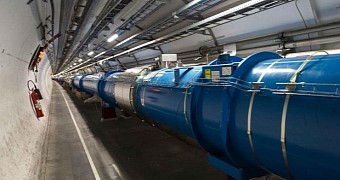Come March 2015, scientists with the European Organization for Nuclear Research, otherwise known as CERN, will restart the Large Hadron Collider, a mammoth installation best described as the world's absolute biggest atom smasher.
This second run is scheduled to last a total of 3 years. Brainiacs with the European Organization for Nuclear Research expect that, during this time, the Large Hadron Collider will help them zoom in on several never-before-seen particles.
More precisely, they hope that the atom smasher will make it possible for them to discover other particles similar to the Higgs boson, which was found back in 2012. Dark matter particles could be discovered during this second run of the Large Hadron Collider as well.
Just how big is the Large Hadron Collider?
The massive installation, located near Geneva, Switzerland, is buried in the ground at a depth of about 175 meters (574 feet). It's nestled inside a ring tunnel measuring 27 kilometers (16 miles) in diameter and lies beneath the Franco-Swiss border.
The Large Hadron Collider packs some 9,600 magnets comprising a total of 10,000 tons of iron. Together, these magnets, the biggest of which measure 15 meters (50 feet) in length, can generate a magnetic field a whopping 100,000 times more powerful than that of our planet.
To keep the Large Hadron Collider from going haywire, these magnets are cooled using liquid helium. Thus, the temperature at which they operate is one of about minus 271.3 degrees Celsius (minus 456 degrees Fahrenheit), scientists with the European Organization for Nuclear Research explain.
How does the installation work?
The Large Hadron Collider works by accelerating beams of protons to nearly the speed of light and then having them smash into one another. Following such collisions, protons are broken apart, massive amounts of energy are released and new particles are created.
It is the magnets that the installation is fitted with that help accelerate the beams of protons to impressive speeds. During its second run, the Large Hadron Collider will produce collisions at an energy of 13 teraelectron volts, which is twice as much as the energy level reached during the first run.
Hence, the installation should make it possible for scientists to identify several particles that have not yet been documented, including dark matter ones. For those unaware, dark matter neither emits nor absorbs light or electromagnetic radiation at a level that can be detected using existing technologies.
It does, however, interact gravitationally with the matter we can see and touch. Based on its observable influence on regular matter, researchers estimate that dark matter accounts for about 80% of the universe. Still, they are yet to identify and study actual dark matter particles.
Commenting on the ongoing efforts to restart the Large Hadron Collider at 13 teraelectron volts, Rolf Heuer, the Organization's current director general, wished to stress, “With this new energy level, the LHC will open new horizons for physics and for future discoveries.” “I’m looking forward to seeing what nature has in store for us,” he added.

 14 DAY TRIAL //
14 DAY TRIAL //